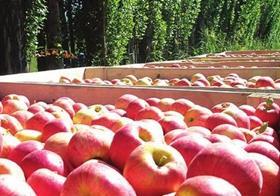
New Zealand pipfruit production and export volumes are likely to fall in 2014, as a result of a biennial bearing “off” year, according to a report released by the USDA.
The report predicts apple production will drop under 512,000 tonnes next year, while pear production is likely to fall below 13,800 tonnes. It would mark a combined 4 per cent year-on-year decline in pipfruit production.
The USDA believes the drop in production will reduce apple exports by 5 per cent to 305,000 tonnes, while pear exports are also likely to fall by 5 per cent to 4,465 tonnes.
Hard act to follow
New Zealand pipfruit exports have enjoyed a highly successful 2013, with apple shipments likely to top 320,000 tonnes by year’s end. Growers are enjoying what the report describes as 'possibly the most profitable year for over a decade', with average FOB prices running 20 per cent above 2012 levels.
Notably, there has been a larger volume of apples sent to the EU in 2013, with an estimated 90,659 tonnes shipped year-to-date, compared with 75,206 tonnes in 2012.
The UK remains the single largest destination for New Zealand apple exports, with around 44,000 tonnes shipped there this year. The US is the sector’s second largest market, with 38,745 tonnes sent year-to-date, a 15 per cent rise on last year.
Asia also looms large, with apple export volumes to China and Hong Kong rising by 37 per cent this year to 21,084 tonnes. Prices also rose 22 per cent in these markets, despite some phytosanitary issues.
“The detection of a post-harvest rot on some fruit in China brought about a voluntary cessation of the trade for the rest of the year,' said the USDA report.
Thailand has also shown promise, with apple exports to the South East Asian nation increasing by over 5,000 tonnes in 2013 (to 25,815 tonnes), while the volume shipped to Taiwan has decreased by over 3,000 tonnes (to 8,858 tonnes) as a result of an increased market presence from the US and Chile.
Varietal spread
Royal Gala remains the most commonly grown apple variety in New Zealand, accounting for over 28 per cent of the area under plantation.
Braeburn production continues to decline, although 18 per cent of all New Zealand plantings are still dedicated to the heavily European market-orientated variety. Plantings of the Cripps Pink and Pacific Queen varieties have continued to rise over 2013.
As growers look to cater for a wider range of markets, the spread of varieties grown in New Zealand has become broader than ever.
“The sector has had a profitable year in 2013 and most growers, packers, and exporters can see a sustainable future now if they can provide the right product into Asia and the Middle East,” the USDA report said.
Planting for the future
Indeed, while the area planted to apples in New Zealand is forecast to remain flat this year at around 8,820ha, it could rise sharply in the future. 'There are anecdotal reports that apple tree orders at nurseries have increased significantly for plantings a couple of years away,' said the report.
In August this year, Pipfruit New Zealand (PNZ) announced its vision to create a billion dollar industry by 2022, almost doubling its current size of around NZ$625m. Achieving that goal would mean increasing earnings by over 60 per cent through a combination of increased plantings, improved productivity and returning a higher proportion of the value chain back to New Zealand. Improving market access is recognised as key to that goal, and it's a top priority in PNZ's eight-point plan.



